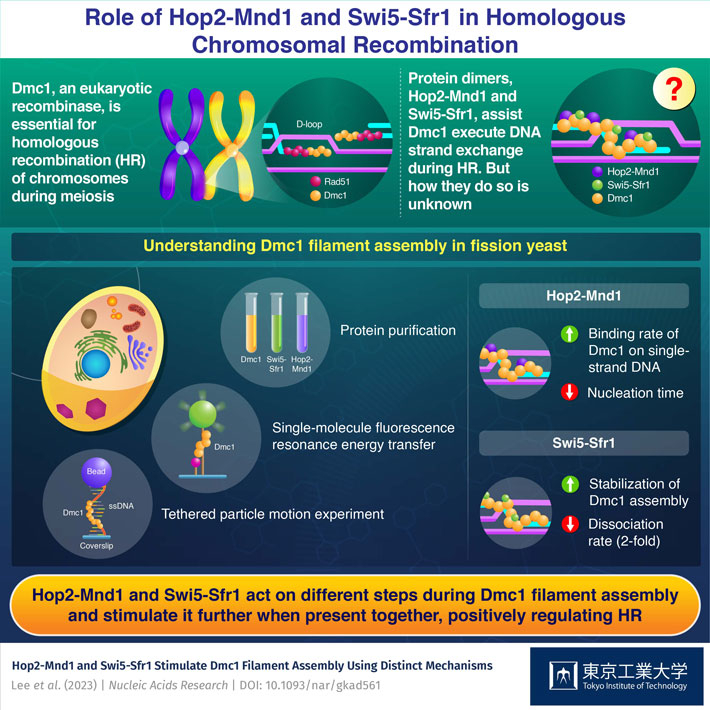Homologous recombination (HR) is an important process that plays multiple crucial roles during meiosis, a type of cell cycle dedicated to sexual reproduction. During HR, homologous DNA molecules exchange their genetic material. During the meiotic prophase, DNA are clipped throughout the genome, forming numerous DNA double-strand breaks. Such DNA breaks attract homologous recombination enzymes, which promote pairing of homologous chromosomes.
Dmc1 is one such meiosis-specific recombinase in eukaryotes (organisms that have a clearly defined nucleus), which along with the general recombinase Rad51, binds to the ssDNA regions formed at the end of broken DNA and facilitates the process of HR. Both Dmc1 and Rad51 preferentially bind ssDNA to form a helical filament structure called presynaptic filament. Critical for its efficient functioning, Swi5-Sfr1 and Hop2-Mnd1 are two accessory factors that help in assembling the Dmc1 filaments on ssDNA. While previous studies have shown that Swi5-Sfr1 and Hop2-Mnd1 make important contributions to the Dmc1-driven strand exchange during HR, the mechanisms underlying their molecular contributions have remained elusive.
Shedding light on their molecular functions, a research team led by Assistant Professor Hideo Tsubouchi from Tokyo Institute of Technology (Tokyo Tech), Japan, and Professor Hung-Wen Li of the National Taiwan University, Taiwan, now reveal how the proteins Swi5-Sfr1 and Hop2-Mnd1 regulate Dmc1 filament assembly. Using single-molecule experiments, they performed this study with proteins from Schizosaccharomyces pombe, a fission yeast species used as a model organism. Their work was published in Nucleic Acids Research journal on 3 July, 2023.
To this end, the researchers first purified Dmc1, Hop2-Mnd1, and Swi5-Sfr1 from S. pombe. They then subjected these proteins to a specialized technique called single-molecule fluorescence resonance energy transfer, which uses a laser beam and DNA substrates labeled with fluorescent chemicals to detect interactions between Dmc1 and DNA. Further, the researchers also conducted tethered particle motion experiments (to observe changes in the shape and configuration of polymers like DNA) to visualize the Dmc1 filament assembly in real time.
Based on these results, the researchers noted that both Swi5-Sfr1 and Hop2-Mnd1 promote the assembly of Dmc1 filament on ssDNA, but in two different ways. Hop2-Mnd1 binds to double/single-strand DNA junctions and initiates the binding of Dmc1 to itself. Swi5-Sfr1 binds to the assembled Dmc1 filament and prevents dissociation of Dmc1 from the presynaptic filament. Thus, they observed that the combination of these two factors contributes to efficient and stable Dmc1 filament formation.
In summary, these findings provide important insights into the mechanisms underlying Dmc1 filament assembly and functioning of its accessory proteins. Going ahead, this could contribute to advancing our understanding of HR in meiosis, a crucial biological phenomenon in eukaryotic reproduction. Although the proteins studied in this paper are from fission yeast, they are widely conserved throughout eukaryotes including humans. Given that homologous recombination is essential for faithful segregation of chromosomes during meiosis, the results obtained in this study are likely relevant to understanding human reproductive systems. They may shed light on understanding the cause of infertility and certain genetic disorders caused by chromosome mis-segregation, such as Down's syndrome.
. Any information published on this site will be valid in relation to Science Tokyo.



